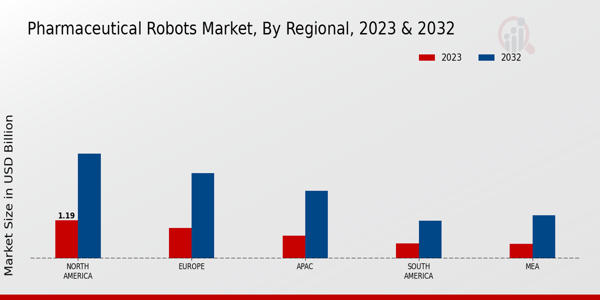Regulatory Compliance
Regulatory compliance is a critical factor influencing the Global Pharmaceutical Robots Market Industry. Stringent regulations imposed by health authorities necessitate the implementation of advanced technologies to ensure product safety and efficacy. Pharmaceutical companies are increasingly turning to robotic systems to maintain compliance with Good Manufacturing Practices (GMP) and other regulatory requirements. Robots can provide consistent and traceable processes, which are essential for meeting these standards. As regulatory pressures continue to mount, the reliance on pharmaceutical robots is likely to increase, further propelling market growth.
Market Growth Projections
The Global Pharmaceutical Robots Market Industry is poised for substantial growth, with projections indicating a market value of 4.18 USD Billion in 2024 and an anticipated increase to 14.8 USD Billion by 2035. This growth trajectory suggests a compound annual growth rate of 12.15% from 2025 to 2035, reflecting the increasing adoption of robotic technologies across various pharmaceutical applications. The market's expansion is driven by factors such as technological advancements, regulatory compliance, and the rising demand for automation, positioning the industry for a transformative decade ahead.
Technological Advancements
The Global Pharmaceutical Robots Market Industry is experiencing rapid technological advancements that enhance automation and efficiency in pharmaceutical processes. Innovations in robotics, artificial intelligence, and machine learning are driving the development of sophisticated robotic systems capable of performing complex tasks such as drug dispensing, packaging, and quality control. These advancements not only improve accuracy but also reduce human error, which is critical in the pharmaceutical sector. The integration of these technologies is expected to contribute significantly to the market's growth, with projections indicating a market value of 4.18 USD Billion in 2024, potentially reaching 14.8 USD Billion by 2035.
Increased Demand for Automation
The demand for automation in the pharmaceutical industry is a key driver of the Global Pharmaceutical Robots Market Industry. As companies strive to enhance productivity and reduce operational costs, the adoption of robotic systems becomes increasingly appealing. Automation allows for streamlined processes, faster production times, and improved compliance with regulatory standards. This trend is particularly evident in the manufacturing and distribution sectors, where robots can perform repetitive tasks with precision. The market is projected to grow at a compound annual growth rate of 12.15% from 2025 to 2035, reflecting the industry's shift towards automated solutions.
Global Supply Chain Optimization
Global supply chain optimization is becoming increasingly vital in the pharmaceutical sector, influencing the Global Pharmaceutical Robots Market Industry. The complexity of pharmaceutical logistics, combined with the need for timely delivery of medications, necessitates the integration of robotic systems. Robots can enhance inventory management, streamline distribution processes, and reduce lead times, thereby improving overall supply chain efficiency. As companies seek to adapt to the dynamic global market, the implementation of robotics in supply chain operations is expected to grow, aligning with the projected market expansion.
Aging Population and Chronic Diseases
The aging population and the rising prevalence of chronic diseases are driving the Global Pharmaceutical Robots Market Industry. As the global demographic shifts towards an older population, the demand for pharmaceuticals and healthcare services escalates. This trend necessitates the efficient production and distribution of medications, which robotic systems can facilitate. Moreover, the increasing incidence of chronic diseases requires a more robust pharmaceutical supply chain, where robots can enhance operational efficiency. The market's growth is thus closely tied to demographic changes and healthcare demands, indicating a sustained need for robotic solutions in the pharmaceutical sector.






















